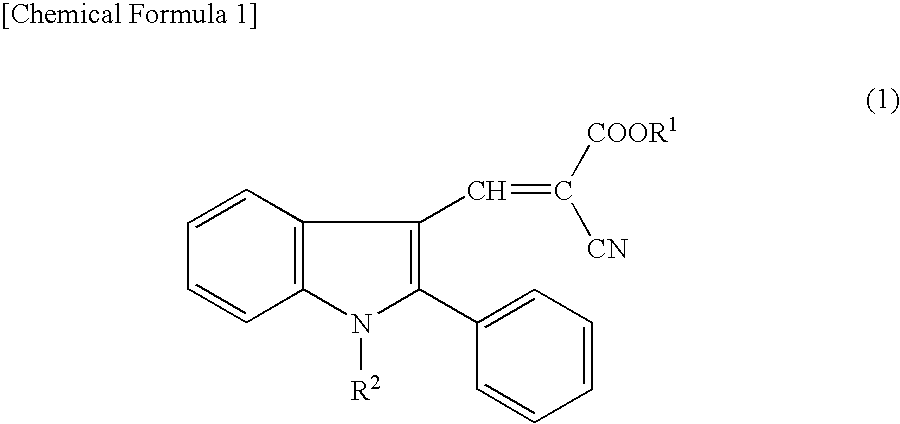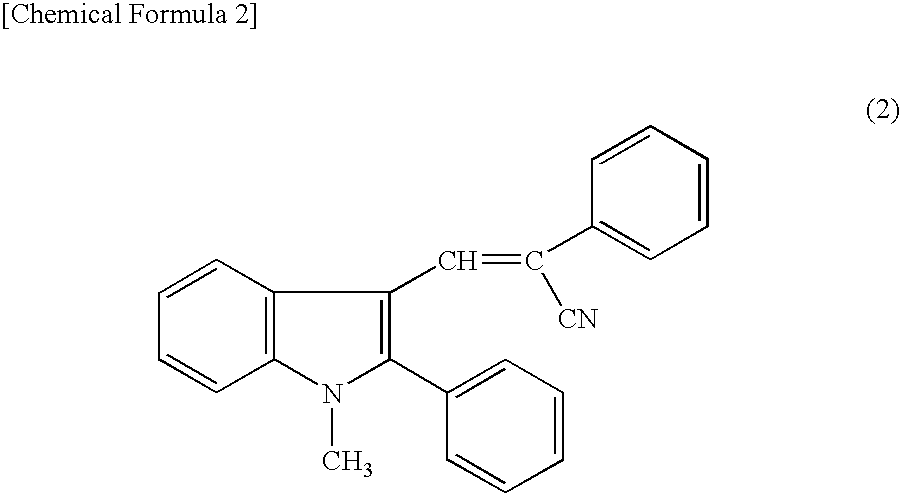Interlayer film for laminated glass and laminated glass
a technology of laminated glass and interlayer film, which is applied in the direction of organic chemistry, synthetic resin layered products, transportation and packaging, etc., can solve the problems of inability to obtain an interlayer film for a laminated glass having inability to sufficiently block ultraviolet rays, etc., to achieve excellent durability to light exposure, reduce ultraviolet ray transmittance, and high visible light transmittance
- Summary
- Abstract
- Description
- Claims
- Application Information
AI Technical Summary
Benefits of technology
Problems solved by technology
Method used
Image
Examples
example 1
(1) Production of Interlayer Film for Laminated Glass
[0093]To 40 parts by weight of triethylene glycol di-2-ethylhexanoate (3GO) as a plasticizer were added 0.4 parts by weight of 2,6-di-t-butyl-p-cresol (BHT) as an antioxidant, 0.4 parts by weight of an ultraviolet absorber (“TINUVIN 326” produced by Ciba Specialty Chemicals Inc.) having a benzotriazol structure, and 0.048 parts by weight of the obtained indole compound A. The resultant mixture was stirred by using a stirrer at 80° C. for 30 minutes to give a plasticizer solution.
[0094]The obtained plasticizer solution was sufficiently mixed with 100 parts by weight of polyvinyl butyral resin (PVB) (average polymerization degree: 1700, butyralation degree: 68.5 mol %, amount of the hydroxyl group: 30.6 mol %, amount of the acetyl group: 0.9 mol %). Then, a twin-screw aeolotropic extruder was used to produce an interlayer film for a laminated glass having a film thickness of 760 μm. In this process, for the purpose of controlling th...
examples 2 to 27
, and Comparative Examples 1 to 15
[0096]Interlayer films for a laminated glass and laminated glasses were produced in the same manner as in Example 1, except that the compositions thereof were changed as shown in Tables 2 to 6. Meanwhile, interlayer films for a laminated glass and laminated glasses were produced in Examples 4, 8, and 12 in the same manner as in Example 1, except that 0.28 parts by weight of tin-doped indium oxide particles (ITO) (volume average particle diameter: 35 nm) were added to the plasticizer solution as an infrared absorber.
(Evaluations)
[0097]The following evaluations were made for each of the laminated glasses obtained in Examples and Comparative Examples.
[0098]Tables 2 to 6 show the results.
(1) Evaluation of Transmittance
[0099]The visible light transmittance (Tv) of the obtained laminated glass (300 mm in length×300 mm in width) was calculated according to JIS R 3106 (1998) by using a spectrophotometer (“U-4000” produced by Hitachi, Ltd.). The solar transm...
example 28
(1) Production of Interlayer Film for Laminated Glass
[0111]To 63 parts by weight of tetraethylene glycol-di-2-ethylhexanoate (4GO) as a plasticizer were added 0.4 parts by weight of 2,6-di-t-butyl-p-cresol as an antioxidant, 0.4 parts by weight of an ultraviolet absorber (“TINUVIN 326” produced by Ciba Specialty Chemicals Inc.) having a benzotriazol structure, and 0.14 parts by weight of the obtained indole compound A. The resultant mixture was stirred by using a stirrer at 80° C. for 30 minutes to give a plasticizer solution.
[0112]The obtained plasticizer solution was sufficiently mixed with 100 parts by weight of polyvinyl butyral resin (PVB) (average polymerization degree: 1700, butyralation degree: 68.5 mol %, amount of the hydroxyl group: 30.6 mol %, amount of the acetyl group: 0.9 mol %). Then, a twin-screw aeolotropic extruder was used to produce an interlayer film for a laminated glass having a film thickness of 760 μm. In this process, for the purpose of controlling the adh...
PUM
| Property | Measurement | Unit |
|---|---|---|
| Percent by mass | aaaaa | aaaaa |
| Nanoscale particle size | aaaaa | aaaaa |
| Volume | aaaaa | aaaaa |
Abstract
Description
Claims
Application Information
 Login to View More
Login to View More - Generate Ideas
- Intellectual Property
- Life Sciences
- Materials
- Tech Scout
- Unparalleled Data Quality
- Higher Quality Content
- 60% Fewer Hallucinations
Browse by: Latest US Patents, China's latest patents, Technical Efficacy Thesaurus, Application Domain, Technology Topic, Popular Technical Reports.
© 2025 PatSnap. All rights reserved.Legal|Privacy policy|Modern Slavery Act Transparency Statement|Sitemap|About US| Contact US: help@patsnap.com



